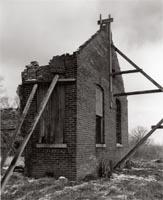 |
||
Afterword to The Common Good A few days after finishing the photography phase of The Common Good, I totaled up the mileage we’d entered in the small log we keep in our car. It added up to about 14,000 miles—all from day trips. When I combined that figure with the mileage we covered in creating our six earlier photography books, I realized Lynn and I had journeyed an astounding 90,000 miles all across our Hoosier state. But, that’s just one of the impressive statistics we’ve racked up since starting Studio Indiana. For just this current book project, we visited approximately 500 locations, which is about average for most of the books we’ve published. That’s a lot—especially in a state often dismissed as consisting of mostly cornfields. Yes, we know there are tens of thousands of acres of farmland. But there’s much more, if you simply take the time to look. To locate subjects, we often seek leads from individuals who have knowledge of special buildings in their locales; county historians; and librarians, in both small burgs and big cities. We also do some of our own library research. However, for us, our favorite discoveries are those we just happen across while going from here to there. Unplanned and irresistible, they serendipitously present themselves, and we thank them by taking their portraits. Perhaps the saddest statistic for us is the number of places we’ve photographed that no longer exist. Lynn and I have estimated that 20 to 25 percent of the buildings and objects in our first photography book, Lingering Spirit (released in 2003), are now only memories. It’s getting to be a regular occurrence for one of us to say, “Didn’t there used to be a house (or barn, or fire truck, or store, or church, or school) over there?” Each time one of these old friends disappears, we’re reminded of how important our work is. Perhaps our photos will be the only visual record of some of these places—the only tangible proof they ever existed. For schools in particular, the number that existed in the past is impressive. Between 1852 and 1857, over 2,700 Indiana schoolhouses were built. By 1875, there were 9,307, which averaged out to over 100 per county. Then, when the first consolidations took place in the late 1800s, half the one-room schools in the state were closed. While a handful continued in operation until the 1950s, those, too, were eventually shut down in favor of larger, centralized facilities. Of course, Hoosier high schools have had a similar fate, with over 600 secondary-school districts now defunct. The result is that, today, the majority of Indiana’s early schoolhouses are gone. Of those remaining, some are meticulously cared for, but many are succumbing to time and the elements. For years, we used to drive by the crumbling remains of a red-brick, one-room school (below) every few months. With its 2x4 wood bracing, it was obvious that someone—someone who cared—was hoping to save what little was left. Yet each time we passed it, a few more loose bricks had fallen to the ground. Would it—could it—be resurrected, we wondered? It’d be a major project, but maybe… Then, it was gone, and the bricks were neatly piled into several small stacks. A few weeks later, all the bricks were gone, and only unmowed weeds remained. I knew that old school was getting to be dangerous, and was probably an insurance liability, but we mourned its loss, as if someone dear had died. I’m sure most of the people who drove past that schoolhouse ruin never even noticed it, and those who did probably considered it an eyesore—but it wasn’t without worth. I’ve come to believe that each rusted vehicle, each battered machine, each deserted building (especially a school or church), is an integral piece of our collective past. So, I’ll continue to honor them by capturing their unique—and irreplaceable—images on film. —JB |
||
 |
||